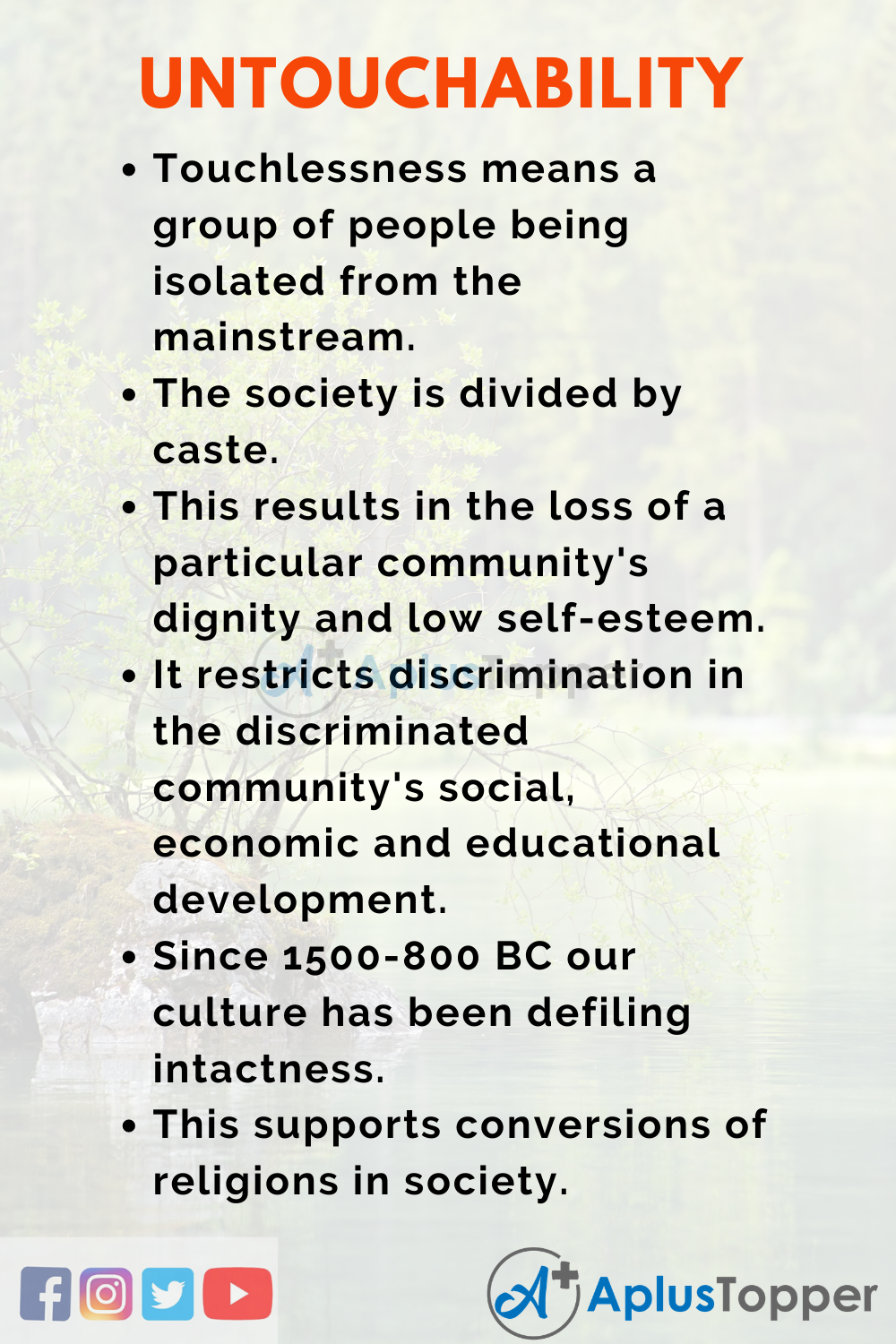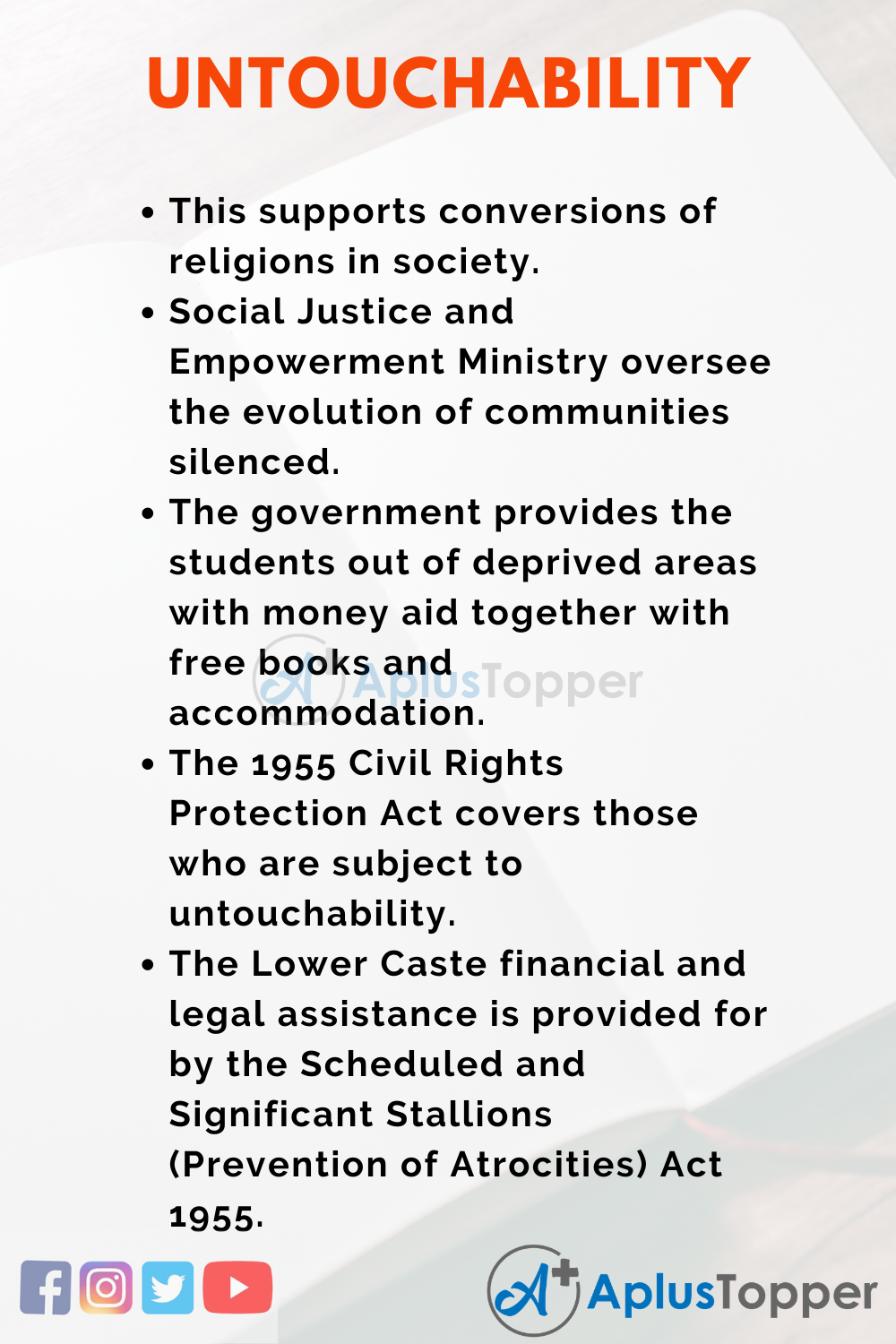Untouchability Essay: Untouchability is the method of discrimination based on their production team and work among different individuals and groups. Untouchability has long been taught. The untouchables are usually treated inhumanely because they are from the lower caste. In almost all places, they have suffered various types of discrimination.
The term Dalit is derived from Sanskrit, meaning broken or downtrodden. Many claim that the untouchability regime still prevails in India, but also in other countries, such as Japan, Tibet and Korea.Vedic texts separating citizens into four key classes have been used to distinguish castes from: Brahmans priests and elite citizens; Kshatrijas warriors; valishias small entrepreneurs and merchants; and Shudras health care staff. Throughout ancient India, these differences were mainly based on caste and the profession of the people.
You can read more Essay Writing about articles, events, people, sports, technology many more.
Long and Short Essays on Untouchability for Students and Kids in English
Given below is the long essay of 400-500 words and is suitable for students of Classes 7,8,9 and 10 and a Short Essay on Untouchability nearly 100-150 words for the students of Classes 1,2,3,4,5 and 6.
Long Essay on Untouchability 500 Words in English
Untouchability is not really special in India; until many centuries ago it was practiced in many parts of The European Union and the Japanese still has many ‘untouchables,’ known as burakumin. But this program remains closely related to culture, faith, history and current politics with the Indian subcontinent. Today in India, more than 169 million people, men, women and young children, are considered to be untouchable and the changes in many of the cases, in spite of legal protections and amendments by the government of the Indian Caste System, have been slower and four caste groups in Hindu world. Brahmines are the found, Kshatriya players and Vaishya traders, the Sudras carry out tedious tasks.
The highest level of the interpersonal hierarchy is Brahmins and the lowest is Sudras. The ties between the community and their sub-castes have been regulated by religious and ethical laws for thousands of years the most important of which is known as Manu Dharma Sastra and also Manu Smriti, which is believed to have already been written on the early Common Era. The Manu Smriti claims that the first aspect of Brahmin’s name must be somewhat favorable, that the brand of Kshatriya must be connected with influence, and that the name of Vaishya should imply wealth. The first part of a Sudra brand should be disdainful and the second half, because of its low beginning, should imply support and modesty.
Only the upper castes are entitled to study the Vedas, according to the Hindu practice. The upper kind is the wedding thread, which takes place only as a wedding rite so that they can finally be called a double-born wedding.
There is positive discrimination in colleges, universities and state jobs and all people from socially and financially backward regions in society are reserved a proportion of their seats and jobs. The practice of untouchability continues, however, and the Dalits remain outside cities, excommunicated by society. They are refused entry into waters or temples, are forbidden from sharing communal wells, maybe forced through separate glasses to drink water in some non-urban cafes, plus frequently harassed or mistreated if signs of mistrust are seen.
Following numerous protests and battling to eradicate untouchability, legislation has been implemented in the Constitution to address the needs of the marginalized groups. Untouchability was abolished and defined as a criminal act in Article 17 of the Indian Constitution. There is no way that anyone can limit the entry to temples, streets, buses, and so on of the Dalits or Harijans. All public services are free to be used with dignity and respect. Furthermore, no one can refuse to sell the Dalit people anything.
These castes are also reserved by the government. Booking means that the population of the lower class is allocated a certain proportion of the seats at government colleges and jobs. This thus guarantees that the development of the present and future is not influenced by the injustice in the past. The reservation also seeks to provide them with a fair opportunity to receive an education that will benefit them and their families and future generations.
Short Essay on Untouchability 150 Words in English
The definition of untouchability today varies from that of ancient India. People become more conscious and adapt themselves to rational thinking. In spite of constitutional amendments, untouchability and caste prejudice still reign in society. Politicians are using it to increase their voting banks and win political control.
Compared to those living in rural areas, the Dalits living in cities are less vulnerable to this discrimination practice. Rural people prefer to follow their conventional convictions, practices and refuse to accept changes to improve society.
Everyone in the eyes of the law is equal. On the basis of their caste, we won’t discriminate and dominate others. Our children should be told of the value of empathy, kindness and equality for all. The Dalits are mainly discriminated against for their jobs, like public areas for cleaning, etc. Ultimately, when our society remains clean and safe, we shall value them most. The new generation should then take over and seek to eradicate it entirely.
10 Lines on Untouchability Essay in English
- Touchlessness means a group of people being isolated from the mainstream.
- The society is divided by caste.
- This results in the loss of a particular community’s dignity and low self-esteem.
- It restricts discrimination in the discriminated community’s social, economic and educational development.
- Since 1500-800 BC our culture has been defiling intactness.
- This supports conversions of religions in society.
- Social Justice and Empowerment Ministry oversee the evolution of communities silenced.
- The government provides the students out of deprived areas with money aid together with free books and accommodation.
- The 1955 Civil Rights Protection Act covers those who are subject to untouchability.
- The Lower Caste financial and legal assistance is provided for by the Scheduled and Significant Stallions (Prevention of Atrocities) Act 1955.
FAQ’S on Untouchability Essay
Question 1.
How does untouchability explain?
Answer:
Untouchability is a practice that considers some people from lower caste to be kept at a distance, denied social equity and disabled by touch, contaminating or polluting those from higher castes.
Question 2.
What are the reasons for this untouchability?
Answer:
Top 3 Untouchability Causes – Explanation!
- Racial factors: racial consideration is one of the fundamental causes of untouchability.
- Religious factors: Another cause of untouchability was religious factors.
- Social factors: Social factors also seem equally important in keeping untouchability.
Question 3.
How have we treated untouchables?
Answer:
Abuse of human rights, known as dalits, is legion on those people. There was a mistake. The Indians Untouchables are protected from the lowest jobs and are constantly afraid that Hindus from the highest caste are publicly humiliated, unclothed, paraded, raped and beaten with wild abandon.
Question 4.
How can I remove untouchability?
Answer:
The evil practice of untouchability can be eliminated the following suggestions:
- Training spread
- Buildings Economic
- Infrastructures to accommodate
- Systems for work
- Dirty annexation enfranchisement
- Caste system abolition
- Promotion of marriages between castes
- Untouchability misinformation
Question 5.
Who started untouchability in India?
Answer:
The Satya Shodak Samaj ‘s founder, Jyotiba Phule, is thought to have coined the term Dalit, a Non-Brahmin movement of Maharashtra. He used the term to call the caste-based social division in Indian society the victim of the untouchable and outcaste people.


